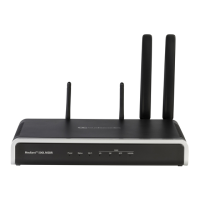User's Manual 29. Configuring Supplementary Services
Version 6.8 467 Mediant 500L MSBR
------=_NextPart_000_4A6D_01CAB3D6.7519F890--
29.11.4.3.2 Pre-empting Existing Calls for E9-1-1 Calls
If the ELIN Gateway receives an E9-1-1 call from the IP network and there are unavailable
channels (for example, all busy), the ELIN Gateway immediately terminates one of the
non-E9-1-1 calls (arbitrary) and accepts the E9-1-1 call on the freed channel.
The preemption is done only on a channel pertaining to the same Trunk Group for which
the E9-1-1 call was initially destined. For example, if an E9-1-1 call is destined for Trunk
Group #2 and all the channels belonging to this group are busy, the ELIN Gateway
terminates one of the calls in this group to free a channel for accepting the E9-1-1 call.
This feature is initiated only if the received SIP INVITE message contains a Priority header
set to "emergency", as shown below:
PRIORITY: emergency
29.11.4.3.3 PSAP Callback to Lync 2010 Clients for Dropped E9-1-1 Calls
As the E9-1-1 service automatically provides all the contact information of the E9-1-1 caller
to the PSAP, the PSAP operator can call back the E9-1-1 caller. This is especially useful in
cases where the caller disconnects prematurely. However, as the Enterprise sends ELINs
to the PSAP for E9-1-1 calls, a callback can only reach the original E9-1-1 caller using the
ELIN Gateway to translate the ELIN number back into the E9-1-1 caller's extension
number.
In the ELIN table of the ELIN Gateway, the temporarily stored From header value of the
SIP INVITE message originally received from the E9-1-1 caller is used for PSAP callback.
When the PSAP makes a callback to the E9-1-1 caller, the ELIN Gateway translates the
called number (i.e., ELIN) received from the PSAP to the corresponding E9-1-1 caller's
extension number as matched in the ELIN table.
The handling of PSAP callbacks by the ELIN Gateway is as follows:
1. When the ELIN Gateway receives any call from the PSTN, it searches the ELIN table
for an ELIN that corresponds to the received Called Party Number in the incoming
PSTN call.
2. If a match is found in the ELIN table, it routes the call to the Mediation Sever by
sending a SIP INVITE, where the values of the To and Request-URI are taken from
the value of the original From header that is stored in the ELIN table (in the Call From
column).
3. The ELIN Gateway updates the Time in the ELIN table. (The Count is not affected).
The PSAP callback can be done only within a user-defined timeout (see ''Configuring the
E9-1-1 Callback Timeout'' on page 469) started from after the original E9-1-1 call
established with the PSAP is terminated. After this time expires, the table entry with its
ELIN is disregarded and no longer used (for PSAP callback). Therefore, table entries of
only the most recently terminated
E9-1-1 callers are considered in the ELIN table. If the PSAP callback is done after this
timeout expires, the ELIN Gateway is unable to route the call to the E9-1-1 caller and
instead, either sends it as a regular call or most likely, rejects it if there are no matching
routing rules. However, if another E9-1-1 caller has subsequently been processed with the
same ELIN number, then the PSAP callback is routed to this new E9-1-1 caller.

